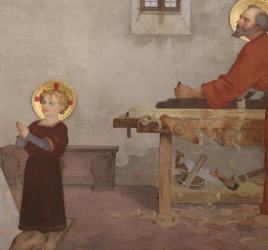
Where You Least Want to Look
A Christian is never alone… If you feel abandoned, it is because you do not want to look at that Christ who is passing so close to you… perhaps with the Cross.
St. Josemaría Escrivá: The Way of the Cross: Sixth Station
Looking creates responsibility, especially when looking means seeing another’s distress. Those who saw the robbed and beaten traveler “half dead” (Lk. 10:30) on the roadside passed by with pretended blindness. They saw him, but a disordered desire for ritual purity won out over compassion.
The first reading for the Feast of the Exaltation of the Holy Cross features a look that saves: the Israelites who had been bitten by poisonous serpents, as a consequence of their murmuring, were told to gaze upon a bronze likeness of the same kind of serpent mounted upon Moses’ staff (Num. 21:4-9). Looking with faith and contrition brought healing.
Jesus, in an extraordinary use of typology, compares Himself to that serpent, lifted up for all to see: “Just as Moses lifted up the serpent in the desert, so must the Son of Man be lifted up, so that everyone who believes in him may have eternal life” (Jn. 3:14-15). The comparison bespeaks infected people, poisoned by sin, and yet sin’s effects are neutralized by gazing upon the crucified with faith and contrition. Where death is the only thing visible, life is renewed within, hiddenly.
Is it easy to look upon Jesus crucified? Isaiah says no.
He had no form or comeliness that we should look at him,
and no beauty that we should desire him.
He was despised and rejected by men;
a man of sorrows, and acquainted with grief;
and as one from whom men hide their faces
he was despised, and we esteemed him not. (Is. 53:2-3)
The crucifix can be, so to speak, a household furnishing or jewelry, neither of which is wrong, but the familiarity can cease to arrest us, can cease to provoke questions we need to ask ourselves. I sometimes ask spiritual directees, “What do you least want to talk about?” And that is our uncomfortable but real starting point. Approaching the thing you dread, you will attain the fruit of the difficult encounter.
The same is true of the cross. What we see in the cross sometimes makes us not want to look too closely: it confronts us with our lack of conformity to Jesus, our fascination with evil, conflicted motivations, and other things we might rather not think or talk about.
Some find Mel Gibson’s The Passion of the Christ practically unwatchable: the graphic spectacle of Jesus brutalized is too much to bear, and no wonder. We can’t look impartially at wounds that we had a hand in inflicting: “But he was wounded for our transgressions, he was bruised for our iniquities” (Is. 53:5). Gibson himself poignantly acted this out when, keeping his face out of view, he held the hammer used to fix the first nail of the crucifixion.
Looking at Jesus in His passion, our shallowness is exposed: we see how easily we are drawn to sin, self-assertion, cowardice, any number of ridiculous things we employ to cope with life’s difficulties. The love we see in the crucifix should totally wreck us, and yet how is it that we get lured by what St Augustine calls, on the verge of his conversion, “mere trifles, the most paltry inanities, all my old attachments” (Confessions, VIII, 11)?
From an intriguing psychological point of view, Dr Jordan Peterson observed during a recent visit to our monastery:
“The crucifix is everything you’re afraid to look at. … It’s the amalgamation of everything about life you don’t want to look at…. The most violent possible death, the most humiliating possible death, young, in front of your mother, despite the fact that you are innocent, even when the crowd knows you’re innocent, when a thief could have been substituted for you…”. [1]
This illustrates a principle elsewhere formulated by Dr Peterson: “What you most want to find will be found where you least want to look.”[2] It’s not difficult to see a gospel principle at work here. The “deep” to which Jesus summons Peter after a long night of catching nothing; the coin Jesus directs Peter to find in the fish’s mouth; the treasure buried in a field; or that place to which Simon Peter will be taken against his will: each is a place you would not want to go or to look, but in which is found a kind of redemption.[3] When Jesus calls us to follow Him, we are accepting any number of places to go, stand, tread water, etc. We have to go where we are out of our element and there find our salvation. In a word, it is the distressing Calvary of daily life, mounted one event at a time.
Our willingness to look into, seek after, and remain in these difficult spaces lands us in the same place as our Master: “Where I am, there shall my servant be” (Jn. 12:26). We need to remember that. If we must lose life to find it, abandon self in order to be our truest self, then feeling abandoned and lost might very well follow. And loneliness in suffering is practically insufferable. But just as Jesus is never alone (Jn 16:32), neither are we, since He promises to be with us and within us always.
If, as St Josemaría says, we resist looking too closely at the cross-bearing Christ, we should know that the cross He carries is ours. And the look He gives us as he passes by does not shame or condemn, but comprehends the full weight of our misery, our unsightly inner darkness, and carries it on His shoulders.
In this way, what you might least want to look at becomes the only thing worth contemplating, because it is the mysterious love that supports and saves you. He wears our unsightliness; He covers Himself with our disgrace; He bears our sicknesses and infirmities. In the mystery of His sacrifice, Jesus makes us whole by carrying the fragments of our brokenness to the cross.
Maybe we experience the dead weight of our personal failings, but our Lord takes into account our mistakes. In his merciful gaze he realizes that we are creatures with limitations, weaknesses and imperfections, that we are inclined to sin (Christ is Passing By, no. 159).
The great mystery of the cross is that Jesus, looking at us with mercy, takes responsibility for us. Looking at the Son of Man lifted up like the serpent, we realize that we are not staring at a spectacle, but making eye contact with Him, meeting a gaze that has always seen us, even before we knew we needed to look to Him to be healed.
Cover Image via Unsplash
[1] The Abbot’s Circle: In Conversation with the Petersons [see 35:00-39:00].
[2] Jordan B. Peterson: 2017 Maps of Meaning 04: Marionettes and Individuals [see 1:32:40].
[3] Lk 5:1-10; Mt 17:27; Mt 13:44; Jn 21:18-19




